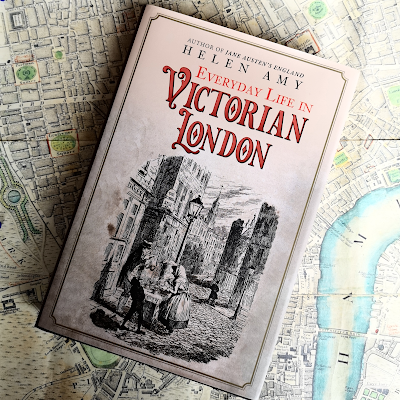Andrew's review:
It’s tricky to write a book about everyday life in Victorian London, the city that became the capital of a global empire. That’s because there is no such place as Victorian London. The London of 1837, when Victoria ascended the throne, was very different to that of 1901, when she died.
During the 64 years of the queen’s reign, the city witnessed massive changes—in size, in wealth and in technology. Transport was just one area that bore witness to these advances. Trains, a novelty in 1837, were commonplace by 1901, when motorcars were making their first appearance on London streets.
Attempting to describe the everyday life of London during this era of momentous change is a major undertaking, even before taking into account the many different strata in London society. Author Helen Amy attempts the challenge in just 250 pages. The result is a series of snapshots, rather than a comprehensive treatment of the subject.
The book is divided into sections that describe different aspects of London life. Individual chapter cover subjects such as:
● Housing
● Education
● The Great Exhibition
● Religion
● Crime
Each chapter is broken into sections. For example, the chapter on education describes a number of specific schools and colleges, the educational opportunities for the poor, and public libraries. Most sections are relatively short, giving highlights with limited detail.
I found that most of the subjects covered in the book were very practical. They related to aspects of life such as homes, schools, shops and entertainment. There’s very little about politics or the matters that might have occupied the everyday conversation, particularly among the reasonably well educated middle classes.
The author makes frequent reference to the sources of information used in the book, and I was pleased to see that she often quotes original reports and journals. These first-hand accounts, the voices of Victorian Londoners, help bring the history to life. We’re permitted to glimpse London as it was in the second half of the 1800s, through the eyes of those who lived there.
Some are observers, often reporting on the plight of the less fortunate. The section on street children allows us to hear from people such as Charles Dickens, who had genuine concern for those living on the margins of society.
 |
| Charles Dickens from The Life of Charles Dickens by John Forster (1872) |
Opened the shutters and lighted the kitchen fire - shook my sooty things in the dusthole and emptied the soot there, swept and dusted the rooms and the hall, laid the cloth and got breakfast up - cleaned two pairs of boots, made the beds and emptied the slops…1
Unfortunately, no dates are given, so we can’t tell which period of the Victorian era it relates to.
While I know London reasonably well, I would have preferred the book to include at least one map. At the very least, this would have helped illustrate the change in size during the Victorian period. I think it would also have been useful to readers unfamiliar with the sprawling geography of the city.
I was pleased to see a number of illustrations, showing different aspects of the everyday London life that the book describes.
My opinion is that this book could be useful to someone looking for a general introduction to the many aspects of life in Victorian London. It doesn’t dig deeply into any subject, but it does highlight a wide range of different topics that could be researched separately.
The writing style is straightforward and clear, making it very accessible. The generous use of quotations from original sources ensures that you’re not simply hearing the author’s opinion. Her statements are backed by eye-witnesses from the time. The book has a reasonable bibliography but the index feels a little thin.
There are many Victorian Londons. Helen Amy makes a good stab at illustrating the various facets of them, from life on and around the River Thames, through to the various flavours of Christian churches available to the public. She closes the book with a short summary of the changes in London over Queen Victoria’s later life, concluding with a short description of the monarch’s final journey to Frogmore, where her burial marked the end of the era.
Note
- Quote from Everyday Life in Victorian London by Helen Amy (2023) p53.
Everyday Life in Victorian London is available from Amberley Publishing here.
If you have enjoyed this blog and want to encourage us and help us to keep making our research freely available, please buy us a virtual cup of coffee by clicking the button below.



No comments:
New comments are not allowed.